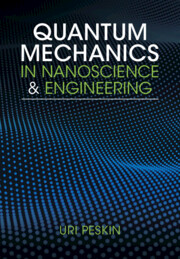Book contents
- Quantum Mechanics in Nanoscience and Engineering
- Additional material
- Quantum Mechanics in Nanoscience and Engineering
- Copyright page
- Contents
- Preface: Who Can Benefit from Reading This Book?
- 1 Motivation
- 2 The State of a System
- 3 Observables and Operators
- 4 The Schrödinger Equation
- 5 Energy Quantization
- 6 Wave Function Penetration, Tunneling, and Quantum Wells
- 7 The Continuous Spectrum and Scattering States
- 8 Mechanical Vibrations and the Harmonic Oscillator Model
- 9 Two-Body Rotation and Angular Momentum
- 10 The Hydrogen-Like Atom
- 11 The Postulates of Quantum Mechanics
- 12 Approximation Methods
- 13 Many-Electron Systems
- 14 Many-Atom Systems
- 15 Quantum Dynamics
- 16 Incoherent States
- 17 Quantum Rate Processes
- 18 Thermal Rates in a Bosonic Environment
- 19 Open Quantum Systems
- 20 Open Many-Fermion Systems
- Index
- References
15 - Quantum Dynamics
Published online by Cambridge University Press: 11 May 2023
- Quantum Mechanics in Nanoscience and Engineering
- Additional material
- Quantum Mechanics in Nanoscience and Engineering
- Copyright page
- Contents
- Preface: Who Can Benefit from Reading This Book?
- 1 Motivation
- 2 The State of a System
- 3 Observables and Operators
- 4 The Schrödinger Equation
- 5 Energy Quantization
- 6 Wave Function Penetration, Tunneling, and Quantum Wells
- 7 The Continuous Spectrum and Scattering States
- 8 Mechanical Vibrations and the Harmonic Oscillator Model
- 9 Two-Body Rotation and Angular Momentum
- 10 The Hydrogen-Like Atom
- 11 The Postulates of Quantum Mechanics
- 12 Approximation Methods
- 13 Many-Electron Systems
- 14 Many-Atom Systems
- 15 Quantum Dynamics
- 16 Incoherent States
- 17 Quantum Rate Processes
- 18 Thermal Rates in a Bosonic Environment
- 19 Open Quantum Systems
- 20 Open Many-Fermion Systems
- Index
- References
Summary
Explicitly time-dependent Hamiltonians are ubiquitous in applications of quantum theory. It is therefore necessary to solve the time-dependent Schrödinger equation directly. The system’s dynamics is associated with a unitary time-evolution operator (a propagator), formally given as an infinite Dyson series. Time-dependent observables are invariant under unitary time-dependent transformations, where it is sometimes useful to transform the time-evolution from the states into the corresponding operators. This is carried out in part (in full) by transforming to the interaction (Heisenberg) picture. The corresponding equations of motion for the time-dependent operators are introduced. For quadratic potential energy functions, the time evolution of quantum expectation values coincides with the corresponding classical dynamics. This is demonstrated and analyzed in detail for Gaussian wave packets and a coherent state. Finally, we derive exact and approximate expressions for time-dependent transition probabilities and transition rates between quantum states. The validity of time-dependent perturbation theory is analyzed by comparison to exact dynamics.
Keywords
- Type
- Chapter
- Information
- Quantum Mechanics in Nanoscience and Engineering , pp. 286 - 319Publisher: Cambridge University PressPrint publication year: 2023

